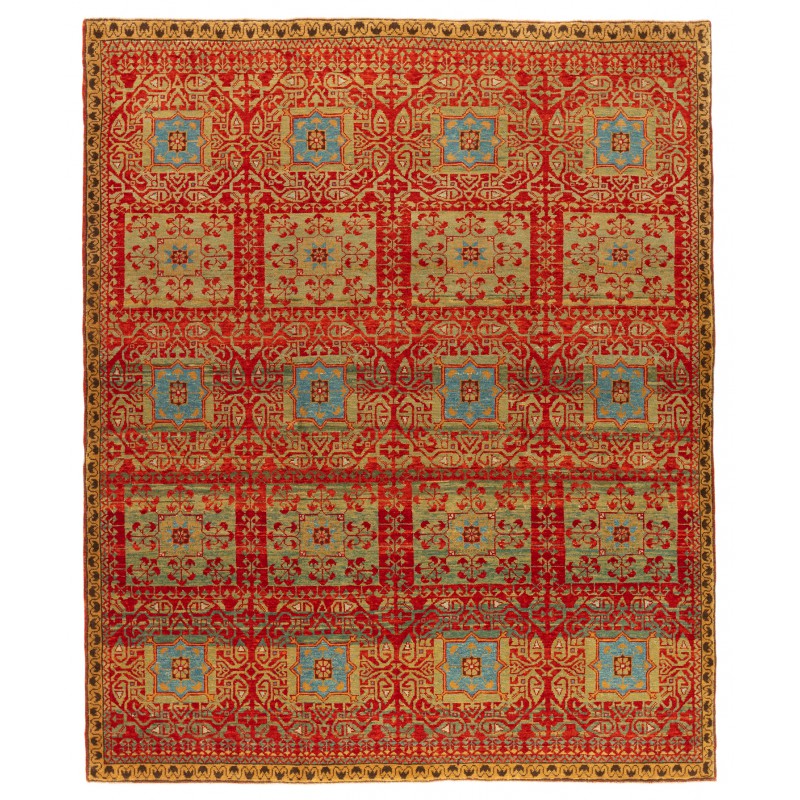
- Stock: 売り切れ
- Model: C40076
- サイズ: 143cm x 177cm
この絨毯の情報は、バイエット・ラトゥール・マムルーク絨毯, Vienna Book(1892年)およびSarre-Trenkwald(1926, pl.48)からのものです。この絨毯は、エジプトのカイロにおけるマムルーク・スルタンによって16世紀初頭にデザインされました。この絨毯は2014年4月8日にクリスティーズロンドンで売却され、ルーブル美術館によって購入されました。この絨毯はデザインがシンプルで、多くのピラミッドの花序が特徴で、珍しい横向きの内側のガードストライプがあります。内側を向いた三角形は、かつて無限に繰り返されるトルクメンスタイルのゴールのパターンの一部であり、ここではほのめかされているに過ぎません。
カイロのワークショップで生産された初期の絨毯を読み解くことは、まったく異なる一連の課題を提供します。カイロの絨毯は、限られたカラーパレット、対称的な結び目、および異例のS-紡績ウールの構造(イスラム世界のほとんどの地域ではZ-紡績ウールが一般的です)によって特徴付けられていますが、オスマン帝国が1517年にマムルーク帝国を征服した後、デザインは突然変化しました。シモネッティ・カーペットは征服後に織られたものであり、マムルークスの「旧世紀のスタイル」を示しています。このカーペットは長くて細く、エジプトの標準的なローラービーム織機で織られ、さまざまな長さの絨毯を生産することができました。デザインにはA-B-C-B-Aのパターンで5つの主要なデザインエリアがあり、最初と最後、2番目と4番目のエリアが対になっており、中央だけがユニークです。これらの5つのデザインエリアをメダリオンと呼ぶことは容易ですが、レイアウトと詳細の両方で幾何学的であり、そのスタイル(織られた日付とは異なる)はメダリオン形式を生み出した絨毯デザインの革命よりも前のものです。マムルーク絨毯のデザインは、虫由来の赤、青、緑、そして時には黄色を組み合わせた独特のデザインと色合いで、早期の近代市場、特にヨーロッパで、アナトリアのより粗く織られ、鮮やかな色合いのウシャクのメダリオン絨毯とは異なる魅力的な選択肢として認識される努力の一環として成立しました。伝統的な幾何学的なマムルークデザインの絨毯の織りは、おそらく17世紀に至るまで続いたようですが、16世紀半ば頃からカイロの織り手たちは、伝統的なマムルークの材料、技法、色彩を使用しながら、イスタンブールのオスマン朝の宮廷で作られていた最新のスタイルを反映した、まったく新しい種類の絨毯を作り始めました。この絨毯のデザインは、私たちのデザイナーによって解釈され、柔らかい色彩がこの絨毯に選ばれました。
The source of the rug comes from the Baillet-Latour Mamluk Carpet, Vienna Book(1892) and Sarre-Trenkwald(1926, pl.48). This rug was designed in the early 16th-century rug by Mamluk Sultane of Cairo, Egypt. This carpet was sold at Christie’s London on 8 April 2014 and purchased by the Louvre Museum. This carpet is simple in design, with a lot of papyrus umbels, and features a rare lateral inner guard stripe. The inward-facing triangles were once part of an infinitely repeating major and minor Turkmen style Göl pattern, only vaguely hinted at here.
Attempting to read early carpets produced in workshops in Cairo provides an entirely different set of challenges. Cairene carpets, distinguished by their limited color palette, symmetrical knotting, and unusual construction of S-spun wool (Z-spun wool being the norm almost everywhere in the Islamic world), underwent a sudden change in design sometime after the Ottoman Turks conquered the Mamluk Empire in 1517. The Simonetti Carpet was probably woven after the conquest but exhibits the “old” fifteenth-century style of the Mamluks. Long and narrow, it was woven on a standard-sized Egyptian roller-beam loom, capable of producing carpets of varying lengths. It consists of five major focal areas of design in an A-B-C-B-A pattern, meaning the first and fifth and the second and fourth areas are paired, while the middle is unique. We can easily term these five focal areas medallions, but they are geometric in both layout and detail, and their style (as opposed to the actual date of the weaving) predates the carpet design revolution that gave rise to the medallion format. We can surmise that the designs and colors of Mamluk carpets, with their unusual combination of insect-derived red, blue, green, and sometimes yellow, with virtually no undyed white at all, constitute an effort to create a recognizable brand in the early modern market, especially in Europe, where Mamluk carpets such as this, with their subtle coloration, incredibly detailed design, and mosaic-like layout of small and intricately patterned geometric motifs, constituted an appealing alternative to the more coarsely woven and brightly colored carpets from Anatolia, such as Ushak medallion carpets. While the weaving of carpets in the traditional geometric Mamluk designs apparently continued well into the seventeenth century, sometime around the mid-sixteenth century, Cairene weavers began to create an entirely new kind of carpet, using their traditional Mamluk materials, technique, and coloration but reflecting the latest styles then being created at the court of the Ottoman sultans in Istanbul. The design of the rug is interpreted by our designers, and soft colors are chosen for this rug.
